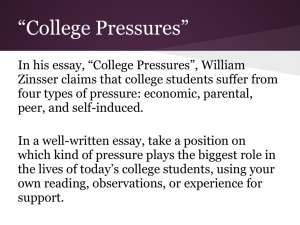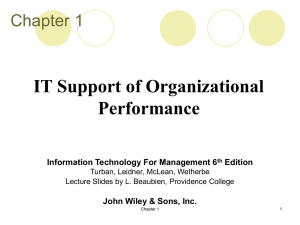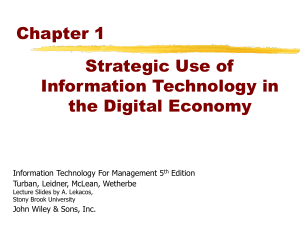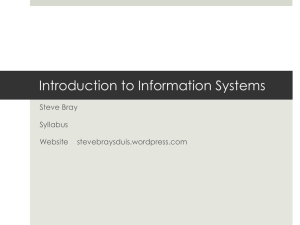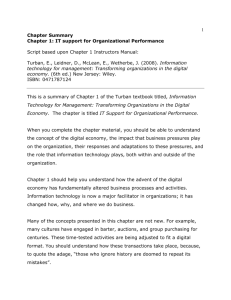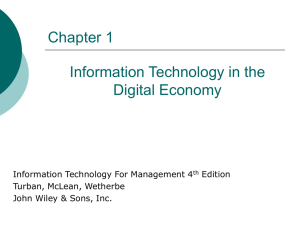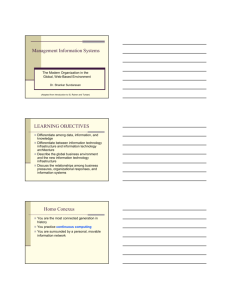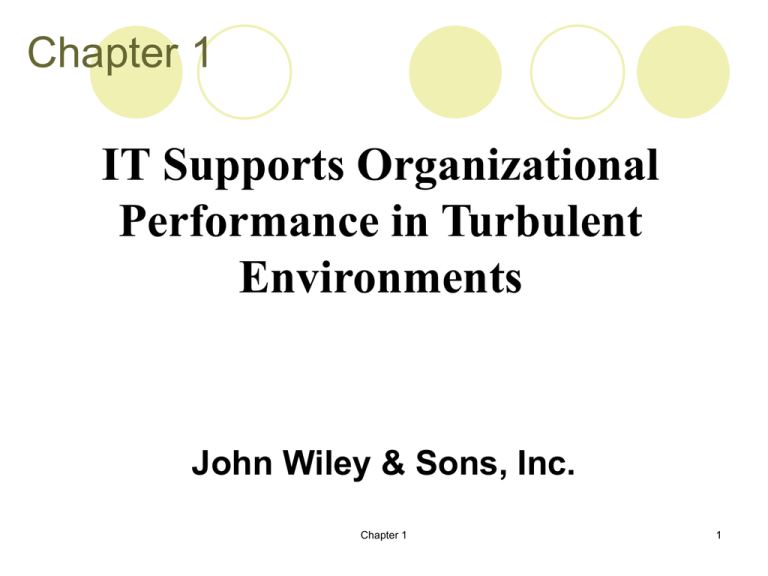
Chapter 1
IT Supports Organizational
Performance in Turbulent
Environments
John Wiley & Sons, Inc.
Chapter 1
1
Learning Objectives
Describe the digital economy and digital
enterprises
Recognize the relationship between
performance, organizational pressures, and
responses and technology
Define IS and IT
Understand what the adaptive enterprise is
Chapter 1
2
Learning Objectives (Continued)
Understand the support role that IS and IT play
in the organization
Understand the importance of learning about IT
Chapter 1
3
Digital Economy – “New” Economy
E-Business: The use of electronic technologies to
transact business
Collaboration: People and Organizations interact,
communicate, collaborate, and search for information
Information Exchange: Storing, processing and
transmission of information
Chapter 1
4
Digital Economy
Based on digital technologies (networking,
communication etc.) that provide the platform
(infrastructure) over which people and
organizations interact and collaborate.
Digitized products
Digitized financial transactions
Everyday objects and appliances equipped with
computing capabilities
Chapter 1
5
Digital Business
Chapter 1
6
The Old Economy – Taking Photo’s
1.
2.
3.
4.
5.
6.
7.
Buy film in a store
Load your camera
Take pictures
Take roll of film to store for processing
Pickup the film when ready
Select specific photos for enlargement
Mail to family and friends
Chapter 1
7
The New Economy – Taking Photo’s
1st Generation Digital Photography
Old economy (except 6 and 7) were replaced by
using a scanner and emailing
2nd Generation Digital Photography
Use a Digital Camera, no film, no processing
3rd Generation Digital Photography
Your Digital Camera is now in your mobile phone,
your binoculars, or palmtop computer.
Chapter 1
8
Major IT Characteristics in the Digital
Economy
Globalization
Digital systems
Speed (need for real-time transactions)
Information overload
Markets moving on-line
Digitization
Innovation
New business models
High rate of obsolescence
New opportunities
New types of fraud and crimes
Wars are going cyber
Digitized organizations
Chapter 1
9
Doing Business in the Digital
Economy
The digital economy is an economy based on digital
technologies, including communication networks (the
Internet, intranets, and extranets), computers, software,
and other related technologies
Also called the Internet economy, the new economy, or
the Web economy
Digital infrastructures provide a global platform over
which people and organizations interact, communicate,
collaborate, and search for information.
Chapter 1
10
The Global Platform of the New
Economy
A huge number of digitizable products; that is products
that can be converted to digital format. Most common
are: books, movies, magazines, TV and radio
programming, electronic games, music CDs, and
computer software.
Consumers and firm conducting financial transaction
digitally.
Physical goods such as home appliances and
automobiles that contain embedded computer chips and
connectivity capabilities.
Chapter 1
11
Electronic Business
Businesses increasingly perform their basic functions:
buying and selling goods and services, servicing
customers, and collaborating with business partners
electronically
This process is known as electronic business (Ebusiness) or electronic commerce (E-commerce)
Chapter 1
12
New Economy vs. Old Economy
Example
Old
New
Buying and selling textbook
Visit the bookstore
Visit web site for publishers
and retailers
Registering for classes
Walk around campus to
Departments, Registrar’s
office, etc.
Access campus web site
Photography
Buy film, use camera, take
picture, take it for processing
Use digital camera
Paying for Gasoline
Fill up your car, go inside, pay
cash or credit card
Use speed pass token; wave
over the sensor and go
Paying for Transportation
Pay cash, metal tokens
Metro cards electronic cards
Paying for goods
Visit store, select item, pay, go
Use self-service kiosks
Supplying commercial photos
Use newspapers, paper,
catalog, or online
Use hub-like supply chain with
digitized picture
Chapter 1
13
Business Models
A business model is a method of doing business by
which a company can generate revenue to sustain itself.
The model spells out how the company adds value to
create a product or service. (Value Chain)
Nokia makes and sells cell phones
A TV station provides free broadcasting. Its survival depends on
a complex model involving advertisers and content providers
Internet portals, such as Yahoo, also use a complex business
model.
Chapter 1
14
Business Models
To define a business model we need to
describe:
Products and services
Business processes
Customers and their value proposition
Supply chain
Revenue model
Chapter 1
15
Digital Age Business Models
Name-Your-Own Price
Reverse Auctions
Affiliate Marketing
E-Marketplaces and Exchanges
Electronic aggregation (buying groups)
Chapter 1
16
Drivers Forcing Changes In Business
Models
Business Pressures
Environmental, organizational, and technological
factors
React frequently and quickly to both the threats
and the opportunities resulting from this new
business environment
Business Critical Response Activities
A response can be a reaction to a pressure
already in existence, an initiative intended to
defend an organization against future pressures,
or an activity that exploits an opportunity created
by changing conditions
Chapter 1
17
The Drivers of change
Society
Market
Chapter 1
Technology
18
Business Pressures, Organizational
Responses, and IT Support
Business Pressure - The business environment is the
combination of social, legal, economic, physical, and
political factors that affect business activities
Significant changes in any of these factors are likely to
create business pressure on the organization
The three types of business pressures faced are:
market, technology, and societal pressures.
Chapter 1
19
Three Types of Business Pressures
Market Pressures:
The Global Economy and Strong Competition
The Changing Nature of the Workforce
Powerful Customers
Chapter 1
20
Business Pressures (Continued)
Technology Pressures:
Technological Innovation and Obsolescence
Information Overload
Chapter 1
21
Business Pressures (Continued)
Societal Pressures:
Social Responsibility
Government Regulation and Deregulation
Protection Against Terrorist Attacks
Ethical Issues
Chapter 1
22
Organizational Responses
Strategic Systems: enable organizations to increase
market share and/or profits.
Customer Focus enable organizations to provide
superb customer service and prevent losing customers
to competitors.
Chapter 1
23
Organizational Responses (Continued)
Make-to-Order is a strategy of producing customized
products and services
Mass Customization is producing a large quantity of
items, but customizing them to fit the desire of each
customer
E-business and E-commerce is the strategy of doing
business electronically
Chapter 1
24
Information System
An information system (IS) collects, processes, stores,
analyzes, and disseminates information for a specific purpose.
Like any other system, an information system includes inputs
(data, instructions) and outputs (reports, calculations). It
processes the inputs by using technology such as PCs and
produces outputs that are sent to users or to other systems via
electronic networks and a feedback mechanism that controls
the operation.
Chapter 1
25
Information System Is A System
Chapter 1
26
Computer Based Information System
Hardware
Software
Data
Network
Procedures
People
Hardware
Software
Application
Data
People
More than hardware and software
Chapter 1
27
The Adaptive, Real-Time Enterprise
Recognizes environmental and
organizational changes as, or even before,
they occur
Deals with changes properly and correctly
Does not wait for competitors to introduce
change (1st mover strategy)
Develop an innovation culture
Have a scalable and appropriate IT
infrastructure
Chapter 1
28
Porter’s Competitive Forces Model
Chapter 1
29
Strategies of competitive advantage
Porter:
Cost leadership
Differentiation
Niche market
Other strategies
Growth
Alliance
Innovation
Operational effectiveness
Customer orientation
Entry barriers
Lock in customers or suppliers
Increase switching costs
Chapter 1
30
Porter’s Value Chain
Chapter 1
31
Managerial Issues
Recognizing opportunities for using IT and Web-based
systems.
Who will build, operate, and maintain the information
systems. How much IT?
How much and HOW important is IT?
Is the situation going to change?
Globalization.
Chapter 1
32
Managerial Issues (Continued)
Ethics and social issues.
Transforming the organization to the digital
economy.
Chapter 1
33
Chapter 1
Copyright © 2008 John Wiley & Sons, Inc. All rights reserved. Reproduction or
translation of this work beyond that permitted in Section 117 of the 1976 United States
Copyright Act without the express written permission of the copyright owner is
unlawful. Request for further information should be addressed to the Permissions
Department, John Wiley & Sons, Inc. The purchaser may make back-up copies for
his/her own use only and not for distribution or resale. The Publisher assumes no
responsibility for errors, omissions, or damages, caused by the use of these programs or
from the use of the information contained herein.
Chapter 1
34

